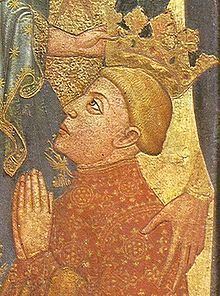Reign 1412–1416 Role King Name Ferdinand of | Burial Poblet Monastery House House of Trastamara | |
 | ||
Children Alfonso V of Aragon, John II of Aragon and Navarre Parents John I of Castile, Eleanor of Aragon, Queen of Castile Similar People Alfonso V of Aragon, John II of Aragon and Nava, John II of Castile, John I of Castile, Henry III of Castile | ||
Ferdinand I (Spanish: Fernando I; 27 November 1380 – 2 April 1416 in Igualada, Catalonia) called of Antequera and also the Just (or the Honest) was king of Aragon, Valencia, Majorca, Sardinia and (nominal) Corsica and king of Sicily, duke (nominal) of Athens and Neopatria, and count of Barcelona, Roussillon and Cerdanya (1412–1416). He was also regent of Castile (1406–1416).
Contents
Biography
Born at Medina del Campo, he was the younger son of King John I of Castile and Eleanor of Aragon.
In 1406, upon the death of his elder brother, King Henry III of Castile, Ferdinand declined the Castilian crown and instead, with Henry's widow Catherine of Lancaster, became coregent during the minority of his nephew John II of Castile. In this capacity he distinguished himself by his prudent administration of domestic affairs.
In a war with the Muslim Kingdom of Granada, he conquered the town of Antequera (1410), whence his surname.
After Ferdinand's maternal uncle, King Martin I of Aragon (Martin II of Sicily), died without surviving legitimate issue, Ferdinand was chosen King of Aragon in 1412 to succeed him in the Compromise of Caspe. The other candidate, Count James II of Urgell (see Counts of Urgell), revolted and Ferdinand dissolved the County of Urgell in 1413.
Ferdinand created the title of Prince of Girona for the heir of the Crown of Aragon on 19 February 1416.
The most notable accomplishment of his brief reign was his agreement in 1416 to depose the Antipope Benedict XIII, thereby helping to end the Western Schism, which had divided the Roman Catholic Church for nearly 40 years.
He is buried in the Aragonese royal pantheon of the monastery of Poblet, in a magnificent tomb ordered by his son Alfonso to Pere Oller in 1417.
The Italian humanist Lorenzo Valla wrote an official biography of Ferdinand, Historiarum Ferdinandi regis Aragonum libri sex.
Family and children
In 1393 Ferdinand married Eleanor of Alburquerque (1374–1435). They had seven children:
Appearance and character
"He was tall, a little more than average, and thin and ruddy, and his cheeks had a few freckles... very patient to all who wanted to talk to him, even if their speeches were ordinary or not well-reasoned..."
